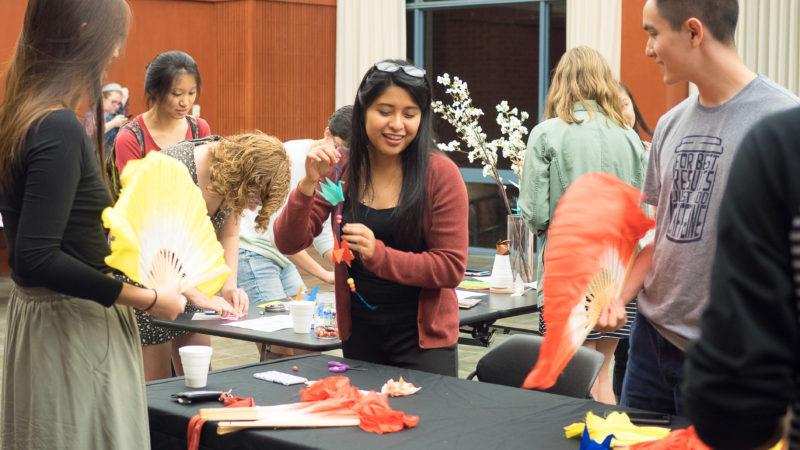On Thursday, October 11 from 6 to 8 p.m. in the Fiesta Room, the Chinese Culture Club (CCC), Japanese Culture Club (JCC), Vietnamese Student Association (VSA) and Filipino Student Association (FSA) celebrated Mid-Autumn Festival with a variety of food and activities.
“It’s a very traditional festival that a lot of Asian countries celebrate. I’m an international student from Vietnam, so I’ve been celebrating that event for my whole life,” said Hoang Le, co-president of VSA. “Usually that event, it’s like a gathering of family and friends, and we go out and celebrate it with mooncakes, with food, and lights and a lot of stuff.”
Mid-Autumn Festival is commonly celebrated in China and Vietnam.
“So it might seem kind of weird, but the Asian cultural clubs, we’re trying to do more collaborations together,” said Ariel Reyes, president of JCC.
Each group brought food from a different restaurant; students who attended were able to try foods from different Asian cultures.
FSA brought pancit, a noodle dish and a dessert called puto, both catered by Lily’s Philippine Bakery and Restaurant.
“Puto is a dessert rice cake “” so usually there’s a small square of cheese on top “” I guess this restaurant added coconut,” said Erika Salarda, president of FSA.
VSA had food catered from Pho Kim Long.
“We brought some not very traditional Vietnamese food, but we had egg rolls, chicken wings and fried rice,” Le said.
JCC brought yakisoba, a Japanese fried noodle dish, and gomoku sushi, both from Niki’s Tokyo Inn.
“I didn’t even get to try it because the food went so fast,” Reyes said of the gomoku sushi dish. “But what it looked like to me was almost like sushi not in the form of sushi, kind of like a sushi casserole. The rice is the base, and [it has] lots of toppings.”
While exact attendance was not counted, there were almost certainly more than 100 students over the course of the event. Le explained that the 120 plates they had bought for food were used up in about 30 minutes.
In addition to this smorgasbord of foods from each cultural club, the festival celebration included bunnies, crafts and fortune telling.
Students were able to pet and hold bunnies, which relates to an idea in East Asian folklore. Saldara explained that the legend says if you look closely at the full moon, you will see the figure of a bunny pounding rice cakes.
CCC also has a paper-cutting craft for students to participate in; they could make Chinese characters or other cutouts. JCC also offered an origami activity where festival-goers could try their hand at making traditional paper cranes, as well as a “cultural photo booth” in which students could try on traditional Japanese clothing.
Reyes explained that the main clothing item at the event were yukata, a light version of the kimono used in the summer.
“We always want to make things educational, but also like with a twist of fun, because otherwise if we just like lectured on Japanese culture or something, it would be just like another class and people would lose interest,” Reyes said. “So the photo booth is one way that we could incorporate Japanese culture.”
In addition, Le explained that VSA was in charge of a “˜fan dance’ activity. Club members taught students how to do the dance, and those who were interested could sign up to perform at Lunar New Year in February. Finally, FSA was in charge of the fortune-telling activity.
“It’s not associated with the Philippines, but fortune-telling is a big cultural aspect in a lot of East-Asian culture. You see it in Vietnamese culture, you see it in Chinese culture, you see it in Japanese culture,” Salarda said. “So they believe that you can tell a lot about a person by reading their palms, reading their facial features, their build.”
Salarda explained that because these types of fortune telling require a lot of skill, FSA used a “cootie catcher” “” folded paper that tells your fortune based on a number that you pick.
“We based it off the usual fortunes that you might see in the Chinese Zodiac,” Salarda said. “So we did education “” because we’re all college students “” health, and of course, always interesting, your love life.”
Reyes explained that the event was a broad celebration of Asian cultures rather than strictly adhering to traditional celebrations of the Mid-Autumn Festival.
“Honestly, the stuff that we did, would they actually do that in China to celebrate mid-autumn festival? Probably not,” Reyes said. “We had mooncakes, which is definitely a mid-autumn festival thing. But other than that, not so much. I guess we kind of turned it just into a way to make a fun event to educate people on Asian cultures in general.”







